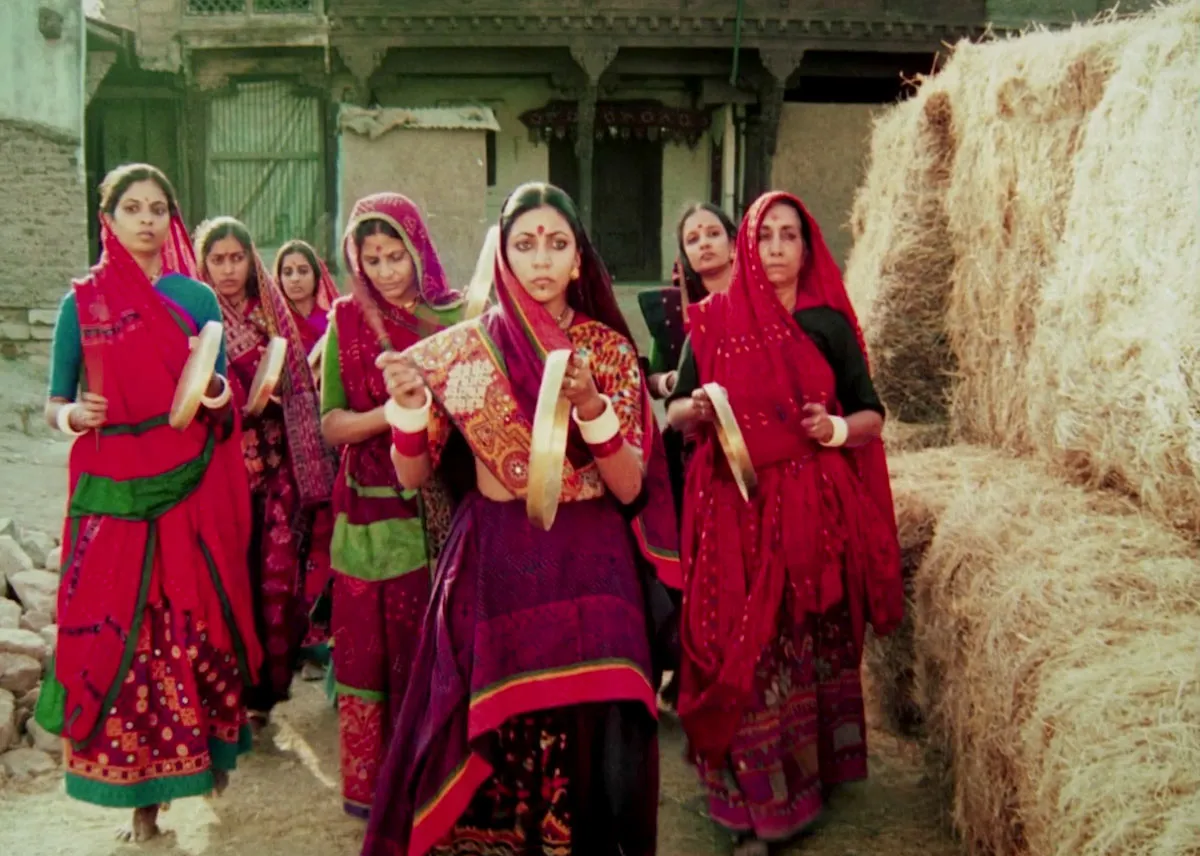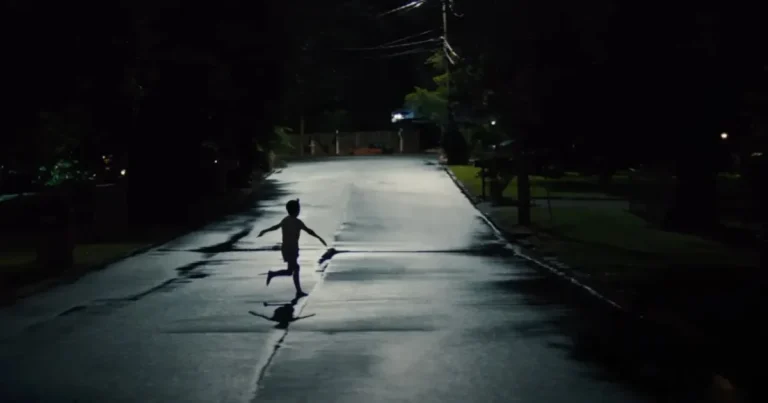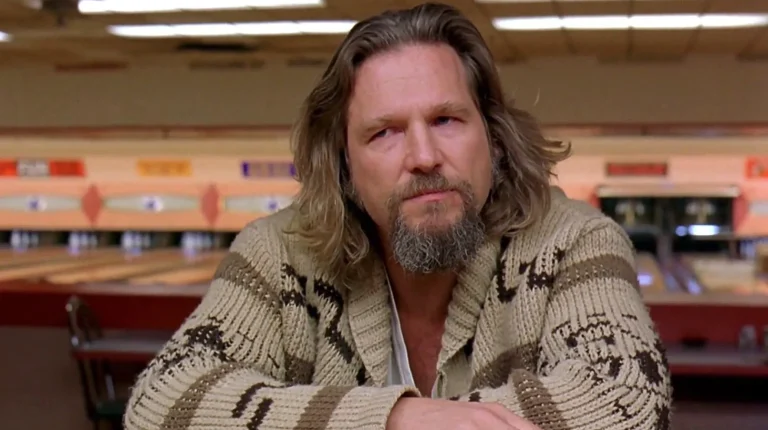The newly appointed subedar is a despot. He laughs malevolently, asks for women at night in his tent, lashes, and loots villagers, stands haughtily astride, and casts his lustful gaze over the horizon until the women of the village organize themselves and confront him. Loosely based on a four-page-long Chunilal Madia story, Ketan Mehta’s 1987 film “Mirch Masala” chronicles the women’s struggle against patriarchy, casteism, and et al. social odds in pre-independence rural Gujarat.
A troubadour, dressed in white, along with his horse, passes through a topsy-turvy wilderness, impregnating the air with his enchanting folk dirge – that’s how “Mirch Masala” begins. The troubadour never appears again in the film; but as he passes, making his voyage toward the unknown, the camera moves on to capture the spice plantation where a miscreant breaks the head of a scarecrow, and we see Subedar (played by Naseeruddin Shah) for the first time, leading his army across the spice-laden red field. Subedar meets Sonbai (played by Smita Patil) for the first time at the riverbank, and this dramatic encounter sets the mood for the rest of the film.
Sonbai restricts Subedar’s cavalry unit from using the water for their horses. In response, Subedar commands his militia to move and he dismounts from his horse. Captivated by Sonbai’s beauty, he kneels in front of her and asks if he may get some water to drink. In this scene, Subedar allegorically personifies himself as an animal. Pointing toward himself, he asks Sonbai, “May this animal have some water?” His brutish cruelty – shown when he beats one of his servants with a sheathed sword for mistakenly breaking a gramophone record – and his boundless lust for the working-class women of the village segregate him from respectful human instincts and highlight in him a dominating, primal, beast-like base urge that at times aggravates him.
Sonbai, a woman of strong resolve, works in a chili powder factory with other village women. Her husband (Raj Babbar), in a frenzy of joy, leaves for the town as he gets a job in the railway service, abandoning Sonbai in a sense. Till the end of the film, we don’t know whether he returns to her or not. Leaving characters’ fate unresolved is a stylistic trait of Ketan Mehta’s narration. Like, Sonbai’s husband one cannot embark on a conclusion, with conviction, about what happened to Sonbai either. However, the first half of “Mirch Masala” shows Subedar’s desperate escalation of desire to seize Sonbai (as if she is property), to quench his lust; whereas the second half deals with a wounded Subedar – since he has been slapped staunchly by Sonbai when he asked her to have sex with him – attempting to blotch Sonbai’s pride and facing her unerring resilience.

As the film rolls on, it minutely distinguishes the characters’ spatial positions in the socio-economic realm and their relentless struggle against patriarchy. Given their economic conditions, the characters’ struggles are varied and directed towards different destinations. While the Mukhi’s wife (played by Deepti Naval) struggles to provide her daughter an education – since girls were not allowed to attend schools in those pre-independence patriarchal societies, Sonbai struggles to persuade her husband to abandon the idea of moving to the city for a new job.
She even cautions her husband by saying: “The city eats everyone.” This remark of Sonbai helps us understand the unfathomable distance rural India used to share with its urban counterpart during the early 20th century; whereas now, moving to a metropolitan area to improve one’s living conditions is a common phenomenon. Juxtaposing images of Sonbai’s calm way of expressing her contentment with life by being able to live upon a few basic daily needs and Subedar’s anger at his servant for breaking a record gives us a vision to decode pre-independence India in terms of class differences.
Although Sonbai has been given a pivotal space in the film – if not as a protagonist but as a representative of her sect or the women’s community of the village – the film does not revolve around her all the time; rather, it meditates on other people’s lives as well. The Mukhi (played by Suresh Oberoi), in a scene, haughtily confronts his wife and admonishes her for sending their daughter to school.
He goes on to demarcate his wife’s limitations in order to justify his keeping of a concubine. Keeping a mistress in those societies was associated with excelling in the social value and dignity of a man. The Mukhi also boasts with pride about his generosity, when he states to his wife, that too in front of their daughter, that she wasn’t blamed for not conceiving a boy-child in her womb even after multiple attempts. It goes without saying that regressive societies in India preferred to celebrate the birth of a boy-child over a girl. Some of these stains on our social fabric are still very much present. Another character that draws our attention in the film is the local school teacher (played by Benjamin Gilani) who strives to educate the villagers to instill a sense of resistance, which was the locals’ need of the hour.
Amid all the odds, the teacher asks Mukhi’s wife to send her daughter to school. He advocates for the downtrodden and tries to save Sonbai from being handed over to Subedar, who threatens to destroy the chili powder factory if Sonbai is not handed over to him. The teacher’s efforts to break the chains bring him nothing but humiliation. This humiliated teacher, beaten black and blue, illustrates the intellectual’s failure to take an enterprise of resistance by instilling rationales in a colonized entity’s collective psyche. The rural colonized populace has been manipulated in such a way by the colonizers that cultivating a logical and rational train of thought in their sterile yet sensitive minds often proves to be an almost impossible job.
The film does not shy away from addressing caste issues, which potentially derails any possible and plausible chance of organizing the rural proletarians against the oppressive power. Here too, while being held hostage inside the factory, Sonbai’s companions address her as ‘Kamjaat’ (low-caste) and ‘Daayan’ (witch). This deep-rooted belief in untouchability and something as occult as witchcraft or sorcery in the villagers’ psyche works as a hindrance in their way of getting organized. Also, there is a local priest who advises Sonbai to accept her fate by sacrificing herself to Subedar for the welfare of the village. All these remarks, tied in the multi-layered fabric of caste, class, and religion, infiltrating from the ingeniously orchestrated mise-en-scène to our mindscapes, open our eyes to locate and discern a woman’s body in a patriarchal social structure.

Ketan Mehta’s “Mirch Masala” can be treated as a landmark in the Indian feminist movement. The final montage of Subedar’s hysteric agony after a downpour of chili powder in his eyes, tacked with a big close-shot of Sonbai’s resolute gaze, with a sickle in her hand – brilliantly shot by Jehangir Choudhary (also the DoP of “Being Cyrus”, “Chachi 420”) – is a testament to the fact that, when an accumulated rage bursts in a volcanic eruption, it takes just a passing moment to organize and act, bypassing all social odds.
Although this insurgence shown in the film is only a slice in time, we don’t know what happened afterward to the women of that particular village. Given the modus operandi of the British Raj, it is hard to believe that the women were left unpunished after committing such an act. But why not look at the brighter side? Who could have said that the very uprising was the first nail in the coffin of patriarchy?
That final act of “Mirch Masala” reminds me of V.I. Lenin’s saying: “The feminine section of the proletarian army is of particularly great significance… the success of a revolution depends on the extent to which women take part in it.” Another important discussion could be drawn by analyzing Abu Miya’s character (played by Om Puri). Abu Miya is the chowkidar of the chili factory, who martyrs himself fighting with Subedar’s army till his last breath. His lifelong commitment to safeguarding the women of the factory – not as a boastful masculine but as a soft-hearted guardian – breaks the infamous masculine notion of protecting women and comments that it takes to have a cultivated humane heart only to stand by the side of a woman.
Despite the societal lessons, Ketan Mehta’s “Mirch Masala” is neither a social commentary nor a slogan on the wall. The film is the ultimate manifestation of images from the pages of a screenplay so well-written that it reminds us that it takes powerful screenwriting, not an obstinate avowal to a certain ‘ism’, to make a powerful yet beautiful political film!







